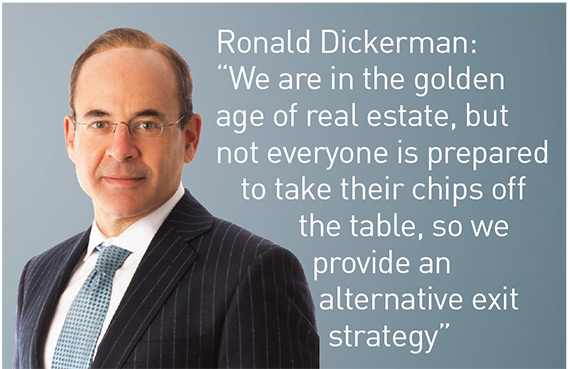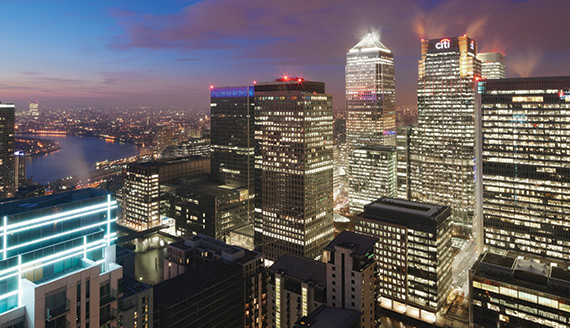The hostile takeover of Canary Wharf thrust Madison International Realty and its unusual brand of real estate secondaries investing into the spotlight. Jack Sidders meets the most prolific trophy asset investor you have never heard of
In the first quarter of 2013, a little-known real estate secondaries investor bought a small stake in the majority owner of Canary Wharf Group, Songbird Estates.
That deal, as with most of those previously undertaken by New York-based Madison International Realty, went unnoticed in London.
But 18 months later, in the midst of a hostile takeover battle for Songbird, Madison found its name in headlines around the world as it became the second shareholder to publicly back Brookfield’s and the Qatar Investment Authority’s revised offer for the company, despite the board’s insistence that the bid failed to reflect fair value.
Its public backing of the bid was met with dismissive reports, suggesting it had no chance of success.
But a few months later, Songbird’s board shocked many commentators by accepting the £3.50 per share offer, which valued the company at £2.6bn.
In the excitement of the bid’s success, Madison’s intervention was little more than a footnote to the story of the deal.
But given that it had bought its 18.3m shares – 2.5% of the company – when they traded at £1.40 per share, it turned out to be a profitable one. On its £25.6m investment, it made a 254% return.
The Canary Wharf deal may have been the first time many in the UK had taken notice of Madison, but the firm’s unusual brand of secondaries investing – which typically buys stakes in buildings as opposed to funds – has seen it involved in some of London’s highest-profile buildings. These include the Lloyds Building, EC3, and Devonshire House, W1.
With its latest City deal – a joint venture with TIAA Henderson on the Houndsditch Estate – promising huge potential, chief executive Ronald Dickerman explains why Madison is all about “friction, tension and mismatches”, and how it has come to be one of the most prolific trophy-asset investors you have never heard of.
Madison’s route to a stake in Canary Wharf is almost as unexpected as its deal sheet, and shows off one strand of the 19-year-old firm’s three-pronged strategy.
The company never set out to buy Songbird shares, but came to it via another deal altogether, says Dickerman.
“We were presented with an opportunity to provide some joint venture equity to a building on Canary Wharf in the Westferry area,” he recalls.
“We began to dig into the opportunity, and we said before we decide to make an investment in a building on Canary Wharf, we better understand Canary Wharf.”
Madison began analysing the likely upside that Crossrail and the residential expansion of the estate at Wood Wharf might bring and took the view that it was undervalued.
But more importantly, it spotted the “elephants living in the shareholder base”.
Canary Wharf’s complex structure was a legacy of its last takeover battle, which left Brookfield holding the majority of the Canary Wharf Group shares not owned by Songbird.
“We looked at the joint ownership structure and it became obvious to us that there was a compelling investment opportunity,” says Dickerman.
“And through our due diligence, we took the time to get to know each of the constituent shareholders.”
Time spent meeting shareholders Brookfield, QIA, Morgan Stanley and Simon Glick’s representatives proved invaluable when, 18 months later, the industry waited to see whether QIA and Brookfield could persuade any of the other major shareholders they needed to back their takeover bid.
It did not take long for the board to reject a £2.95 per share offer, but when that figure was revised up to £3.50 – a significant premium to Songbird’s triple net asset value – Madison broke ranks despite the continued lukewarm reception from the board.
“We signed on publicly to support the Brookfield bid because we were clear that it did represent full and fair value for the estate,” says Dickerman.
 A frothy yield
A frothy yield
“Our view is it was a very frothy yield, and we ran our own numbers on a go-forward rate of return. It struck us that it was quite a low return that was backed by a lot of development speculation.”
At the time of its public backing for the bid, it still seemed to many like the takeover would fail, given repeated statements from the board that £3.50 per share was not enough.
So was Madison confident the bid would win the day, contrary to the board’s public statements?
“There was uncertainty, but we looked to our management team as our fiduciary and said, to the extent they are not prepared to accept the bid, how will you deliver similar value to shareholders and over what period of time?
“Our view was unless you can answer that question definitively, then you should seriously consider accepting the bid. We stayed resolute in that view and communicated that view very clearly to management and history dictates the direction they took.”
Investing in public companies is one of three main strands to Madison’s strategy. The firm was founded by former investment banker Dickerman, who specialised in creating closed-ended funds and syndications of real estate assets to high-net-worth buyers.
The funds were big business on Wall Street in the late 1980s, but with the recession in the early 1990s, many investors began seeking a way out.
“I became an entrepreneur and took a look at this closed-end funds industry in real estate and thought there was an ability to get exposure to the real estate assets by buying out the underlying shareholders to provide them with early liquidity,” Dickerman says.
That early realisation has come to inform much of what Madison has done ever since.
At the turn of the millennium, it began targeting German closed-ended funds, which had become common buyers of trophy assets in the US and elsewhere.
The strategy was similar and the firm’s ability to provide liquidity to investors in the funds gave it access to some prime real estate.
Friction and tension
“What we have discovered is that friction, tension and mismatches often build up in the holding period of the properties, versus the liquidity needs of some of the other underlying investors,” says Dickerman.
In 2002 the firm opened a European HQ in Frankfurt headed by Michael Siefert, before opening in London in 2010, an office now run by Alex Lukesch.
Madison first became active in the UK market in 2006, building a circa 20% stake in the Lloyds Building, EC3.
The building had been bought by Commerzbank in 2005 for £230m, with the equity syndicated to hundreds of private investors in a closed-ended vehicle.
Commerz first considered an exit of the entire building in the second half of 2007, but it would be another six years before it finally completed a disposal to Chinese insurer PingAn for £260m, allowing Madison plenty of time to build its interest gradually in the iconic building.
Targeting joint ventures
The firm’s other strand is more straightforward joint venture partnerships, where it buys into trophy assets alongside principal investors that wish to reduce their equity exposure or create liquidity.
Its first deal of this kind in London was Devonshire House, W1, the Mayfair office block that was sold to Amancio Ortega in late 2013 for £400m.
Madison acquired a minority interest in the building in 2008 via its acquisition of a bridge equity loan from Lehman Brothers, shortly before the bank collapsed.
Last December it teamed up with TIAA Henderson to buy a 50% stake in the Houndsditch Estate, a £200m five-building portfolio that occupies a 1.8-acre freehold island site in the City.
That deal also came as a shock to many, with TIAA Henderson originally planning to sell 133 Houndsditch, the largest of the individual buildings, to raise some liquidity for its Central London Office Fund.
Madison spotted that the building had marriage value with the Cutlers estate next door, which was also held by the fund, and persuaded the fund manager to sell a half-share in the entire estate instead of the whole of the trophy building within it.
While the short- to medium-term strategy will simply be to manage the assets individually and renew leases and fill voids, the longer-term potential is for a significant redevelopment, albeit Madison is likely to exit the investment before that becomes a possibility.
Funding the sixth fund
The firm is now reported to be raising its sixth fund with a target of $950m (£611.5m), having closed its $825m fifth fund in 2013.
But for a firm that is all about exploiting opportunity from those in need of liquidity, in a mainly rising market, is there still enough upheaval in the market to make such investments?
“There have been so many real estate assets held for a relatively long time in their existing structures, and yet the economic cycle seems like it is going on longer than most people expected,” says Dickerman.
The fact interest rates have stayed lower for longer than anyone expected has altered fund managers’ views on when the best time to sell might be, he says, with many now postponing divestment strategies until 2017 or 2018.
“But underlying investors are saying, wait a minute, I have owned this with you since the global financial crisis, and I am just not willing to wait another three to five years,” he adds.
“The sun is shining brightly on commercial real estate. We are in the golden age of real estate, but not everyone is prepared to take their chips off the table right now, so we provide an alternative exit strategy.”












